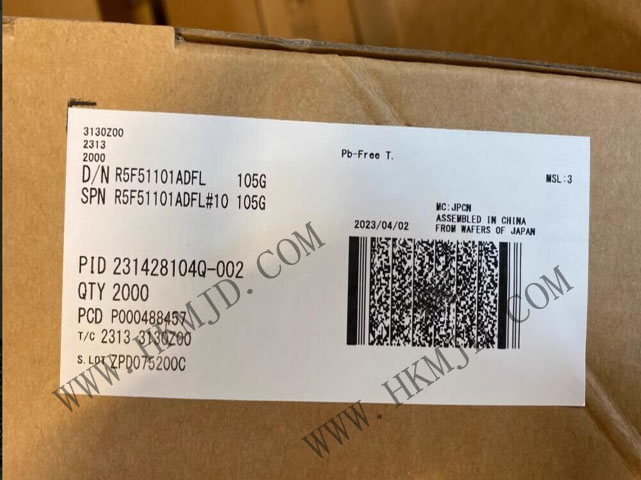Renesas R5F51101ADFL Ultra-Low Power 32MHz 32-Bit RX MCU
Shenzhen Mingjiada Electronics Co., Ltd. is a well-known distributor of electronic components, offering the
R5F51101ADFL ultra-low power 32-bit RX microcontroller in stock. The R5F51101ADFL device stands out for its exceptional energy efficiency, extensive peripheral interfaces, and robust processing capabilities, making it an ideal choice for low-power applications such as IoT terminals, portable medical devices, industrial sensors, and smart home systems.
The R5F51101ADFL belongs to the RX100 series of 32-bit microcontrollers, featuring an advanced RXv1 CPU core. It delivers up to 50 DMIPS of processing performance at a 32MHz clock speed while maintaining industry-leading ultra-low power consumption. The
R5F51101ADFL MCU is packaged in an LQFP-48 package and operates within a temperature range of -40°C to +85°C, making it suitable for harsh industrial environments.
CPU architecture: 32-bit RXv1 core, supporting single-cycle multiplication instructions and DSP-like operations
Operating frequency: Up to 32MHz, with multiple low-power operating modes
Memory resources: The R5F51101ADFL features 128KB of Flash memory (supporting background operations) and 16KB of SRAM
Power management: Operating voltage range of 1.8V to 3.6V, with standby current as low as 0.3μA (typical)
Analogue peripherals: 12-bit ADC (8 channels, conversion rate of 1μs), 12-bit DAC (1 channel), and comparator
Digital Interfaces: UART/SCI (3 channels), SPI (2 channels), I²C (2 channels), and a multi-function timer array
Security Features: The R5F51101ADFL integrates an AES-128 encryption engine and a memory protection unit (MPU)
The R5F51101ADFL employs Renesas' proprietary Snooze mode technology, allowing the CPU to enter sleep mode while maintaining peripheral operations (e.g., ADC, serial port), with typical current consumption as low as 1.2μA. Additionally, the R5F51101ADFL's fast wake-up feature (transitioning from standby mode to full-speed operation in just 5μs) significantly enhances the battery life of battery-powered devices.
1. IoT Terminal Devices
Wireless Sensor Nodes: Integrated with LoRa, BLE, or Zigbee modules to build ultra-low-power environmental monitoring systems
Smart Meters: Metering and wireless reading applications for water meters and gas meters, with battery life exceeding 10 years
Asset tracking tags: Utilising the MCU's low-power characteristics to achieve intermittent collection and transmission of GPS/Beidou positioning data
2. Portable medical electronics
Wearable health monitoring: Devices for collecting physiological parameters such as heart rate, blood oxygen, and body temperature
Handheld diagnostic instruments: Battery-powered medical devices such as blood glucose meters and portable ECGs
Smart drug delivery systems: Portable devices for precisely controlling drug release dosage and timing
3. Industrial automation
Industrial sensors: 4-20mA transmitters, vibration sensors, temperature and humidity transmitters, etc.
HMI control panels: Low-power human-machine interfaces supporting touch input and segmented LCD drivers
Predictive maintenance nodes: Equipment status monitoring and edge computing applications
4. Consumer electronics
Smart home controllers: Zigbee/Bluetooth Mesh nodes for door locks, curtains, lighting, etc.
Remote control devices: TV/air conditioner remote controls, game controllers, etc.
Electronic price tags: supermarket electronic shelf label (ESL) systems
If you are interested, please contact Mr. Chen:
QQ: 1668527835
Tel: 13410018555
Email: chen13410018555@163.com


